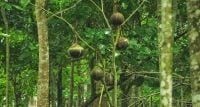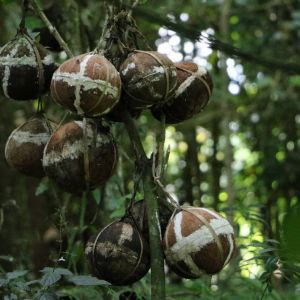Where did this ceremony take place:
In English
In Balinese birth tradition in general, the placenta is planted in the yard of the house near the entrance. However, the people of Bayung Gede Village, Kintamani, actually hang the placenta on a bukak or bintaro tree (Cerbera maghas). As soon as a baby is born, the father prepares a coconut shell split into two. The washed placenta is then put into the coconut shell, then mixed with lime, turmeric, lemon, and other spices such as pepper. Then the coconut shell (called “kaoo”) is glued back and then tied.
The baby's father then goes to a place in the south of the village known as Setra Ari-Ari or Setra Kau, then hangs the wrapped placenta on the bukak tree. Then, on his way home, he picks fern leaves to put at the door of his house as a sign that his family is in a period of impurity (cuntaka) for forty-two days. The fern leaves are a sign that the family is not allowed to enter any holy places and is not allowed to carry out traditional activities for a certain time.
The tradition of hanging the placenta is related to a legend that is believed from generation to generation by the people of Bayung Gede Village. It is said that the ancestors of the Bayung Gede villagers came from a wooden stick that was made alive with water of eternity (tirtha kamandalu) by Hanuman, the son of Lord Bayu. Because their ancestors came from wood, they believe that they will return to wood. That is the reason why they hang their babies’ placenta. This legend is similar to the origin of the Kayu Selem descendants who is also one of the Bali Aga community groups in the northern Bangli region.
According to public belief, the hung placentas do not smell because their odor is obscured by the fragrant smell of wood around Setra Ari-Ari. In addition, the mixture of spices and warming spices dries the placentas faster so they don’t smell.
In Balinese
In Indonesian
Dalam tradisi masyarakat Bali pada umumnya, ari-ari bayi ditanam di halaman rumah di dekat pintu masuk. Akan tetapi, masyarakat Desa Bayung Gede, Kintamani, justru menggantung ari-ari di pohon bukak atau bintaro (Cerbera maghas). Segera setelah bayi lahir, ayahnya menyiapkan tempurung kelapa yang dibelah dua. Ari-ari yang telah dicuci bersih kemudian dimasukkan ke dalam tempurung kelapa itu, lalu dicampur dengan kapur sirih, kunyit, lemon, serta rempah-rempah lain seperti merica. Tempurung kelapa (kau) itu kemudian direkatkan lagi lalu diikat.
Ayah si bayi kemudian akan pergi ke tempat di selatan desa yang dikenal dengan nama Setra Ari-Ari atau Setra Kau, lalu menggantung air-ari itu di pohon bukak. Kemudian, tatkala perjalanan pulang, dia memetik daun pakis untuk ditaruh di pintu rumahnya sebagai pertanda bahwa keluarganya dalam masa tidak suci (cuntaka) selama empat puluh dua hari. Daun pakis itu menjadi pertanda bahwa keluarga itu tidak boleh masuk ke tempat suci dan tidak boleh melakukan kegiatan adat selama waktu tertentu.
Tradisi menggantung ari-ari ini berkaitan dengan legenda yang dipercaya turun-temurun oleh masyarakat Desa Bayung Gede. Konon, leluhur orang desa Bayung Gede berasal dari tongkat kayu yang dihidupkan dengan air kehidupan (tirtha kamandalu) oleh Hanuman, putra Dewa Bayu. Karena berasal dari kayu, maka mereka percaya bahwa mereka akan kembali kepada kayu. Itulah yang menjadi dasar mengapa mereka menggantung ari-ari. Legenda ini mirip dengan asal-mula keturunan Kayu Selem yang juga adalah salah satu kelompok masyarakat Bali Aga di wilayah Bangli utara.
Menurut kepercayaan masyarakat, ari-ari yang digantung itu tidak mengeluarkan bau karena disamarkan oleh bau harum kayu-kayuan yang ada di sekitar Setra Ari-Ari. Selain itu, campuran rempah-rempah dan anget-anget (rempah-rempah penghangat) mempercepat keringnya ari-ari sehingga tidak berbau.
BAMS HISTORY
https://www.youtube.com/channel/UCtKxZsoR9v6sizcoIfqKLhg








Enable comment auto-refresher